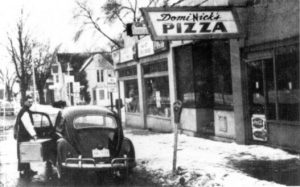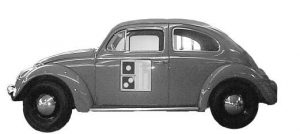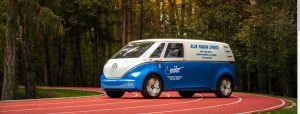
Domino’s original delivery Beetle. Photo courtesy Domino’s.
Many successful companies trace their heritage to a small business that started as a passion project. Surprisingly, some of these now-famous companies credit a Volkswagen model as a key player in the early days of their business.
Domino’s Delivery Beetle
Brothers Tom and James Monaghan founded Domino’s Pizza in 1960 when they bought a small pizzeria in Ypsilanti, Michigan. The brothers purchased the store for only $900 and decided to keep the original name, DomiNick’s. They were given a 15-minute lesson on making pizza from the original owner, Dominick, before opening the shop.
During the first year, both brothers worked tirelessly making and delivering pizzas with the help of a 1959 Volkswagen Beetle, the company’s original delivery vehicle. Within a year, James, who had a full-time job as a mail carrier, sold his share of the pizzeria in exchange for the VW Beetle.

Domino’s Delivery Beetle. Photo courtesy Domino’s.
The store went on to experience a great deal of success and was renamed Domino’s Pizza after Tom learned he was unable to franchise the original owner’s name. Domino’s Pizza, Inc. has become a publicly traded company on the New York Stock Exchange as well as a dinnertime staple.
While the whereabouts of Domino’s first delivery vehicle is unknown, a replica of the original VW Beetle is showcased at Domino’s headquarters, as a nod to the company’s roots and early days in delivery.
Ben & Jerry’s Type 3 Squareback
The iconic ice cream company Ben & Jerry’s was founded in 1978 when two childhood friends, Ben Cohen and Jerry Greenfield, took a $5 correspondence course on ice-cream making from Penn State.
With a $12,000 investment, Ben and Jerry opened the first “scoop shop” in Burlington, Vermont, in a converted gas station. The store became popular around the area thanks to the flavorful ice cream and oversized chunks in the ice cream, a result of Ben’s rare sinus condition known as anosmia that made it difficult for him to smell and taste food.
In addition to the original shop, Ben and Jerry delivered 2.5 gallon tubs of ice cream to restaurants and shops in Ben’s red Volkswagen Type 3 Squareback station wagon. The Type 3 was the pair’s delivery vehicle of choice until 1980, when they upgraded to a larger refrigerated truck to keep up with the growing demand.
Through the years, Ben & Jerry’s has continued to embrace its brand heritage, 60s’-inspired business values, and fun nature. While the original Type 3 Squareback may have fallen victim to Vermont’s harsh winters and road salt, Volkswagen Type 2 Bus vehicles are popular attractions and included on memorabilia at many Ben and Jerry’s scoop shop locations.
Nike’s Type 2 Bus
Before adopting the iconic brand name and logo, Nike was originally known as Blue Ribbon Sports (BRS). University of Oregon track coach, Bill Bowerman, and Oregon native Phil Knight founded BRS in 1964 as an athletic shoe company that specifically catered to runners.
At the time, the running community was still small and widely unknown. With a specific product directed at this small subculture of athletes, BRS was the first of its kind and fostered a small but enthusiastic community of runners.
The company’s first retail store opened in January of 1967 in Santa Monica, California. Blue Ribbon Sport’s first employee, Jeff Johnson, played a crucial role in opening and managing the shop, and drove his personal vehicle, a Volkswagen Type 2 bus, to track meets where he sold and delivered shoes to local runners out of the bus. The outreach at these different events was critical in building that community of runners.
In 1972, BRS rebranded as Nike and launched their first shoe line. Though the original BRS store closed in 1969, the efforts of Johnson foreshadowed the jogging boom of the 1970s and laid the foundation of Nike’s emphasis on customer engagement.

Nike’s Volkswagen ID. BUZZ CARGO. Photo courtesy Volkswagen.
In 2019, Volkswagen and Nike teamed up to celebrate their shared history as well as look to the future. The companies outfitted a Volkswagen ID. BUZZ CARGO concept van to resemble the original Blue Ribbon Sports delivery van, promoting Nike’s “Reuse-A-Shoe” program and Volkswagen’s electric future.
